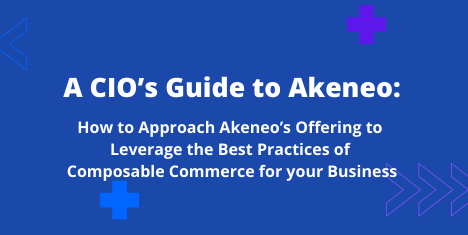How to Approach Akeneo’s Offering to Leverage the Best Practices of Composable Commerce for your Business
Product data is critical to any modern commerce system. Many articles espouse the benefits of a mature product experience, but how you get there is the challenge of the business leaders. The right tool for the right job is essential to most challenges in life, and a dedicated PIM for product data management is no exception. Yes, there are other options in the form of MDM’s that can manage product data along with others, but it’s not as specialized or user friendly. Data governance and efficient enrichment with accessible endpoints for easy integrations lead many clients to Akeneo as their PIM selection.
But which version? Akeneo is a proud member of the MACH Alliance (more on this later) and offers two different SaaS products; a PaaS product, and a fully open source, both free to download community edition. Akeneo has evolved over time, and my recommendations have adapted accordingly. Below is an overview of features and trade-offs for the different Akeneo versions:
Community Edition: (Free … but like a puppy is free)
This is the core back-end of Akeneo’s application, available for free on their github page to download, install, and customize however you see fit. It’s based on the PHP Symfony framework and as all open source programs are, highly customizable. This is a great way to test out the user interface and basic features of Akeneo. It also could be the right fit for your company if you are only looking for basic rights management, limited asset support, and no nested data.
However, just like puppies, there is no such thing as ‘free’ software without the catch: this is an on premise solution where you will have to install, update, and support this on your own. Hosting costs alone (we recommend Ubuntu 20.04 with at least 100GB drive and 8gb of RAM) could be into the $1000’s, but the real cost here is support and maintenance. Monthly patch updates and major version upgrades yearly add up quickly. Before you take the budget option be sure to do an analysis on hosting and support costs to have an accurate comparison. I would only recommend this if you already had an on premise version of Magento Community and had the PHP expertise necessary to handle the upgrades in house.
Growth Edition: SaaS meets Community Edition
A Relatively new offering, Growth Edition is a SaaS version of Akeneo offered to remove the overhead and concerns of self hosting community edition. As such, you can fully embrace the composable commerce movement and interact with it via API connectors for a fully modular ecommerce experience. In addition to everything included in CE, you also get any community available features as soon as they are released (including table attributes and tailored exports) and the ability to leverage the syndication features Akeneo offers as a separate service.
The trade-off here is you miss out on a number of key enterprise features most consider essential to PIM: nested data attributes called reference entities, asset management, and advanced workflow and user permissions. This would be fine for small price conscious organizations looking to move from spreadsheet based enrichment to their first PIM, but the advanced asset management functionality in EE is worth the costs for most clients we work with. (Ask yourself, do your customers want images, pdfs, and videos to evaluate products?)
Enterprise Edition (on-prem):
Akeneo has moved away from this offering and no longer offers it. This was available historically, but paying for your own servers and hosting when the Flexibility (PaaS) offering includes their hosting costs doesn’t make sense.
EE Flexibility (PaaS):
Flexibility is the Akeneo name for their Platform as a Service offering. This contains all of the enterprise features of Akeneo including advanced asset management, reference entities (nested attribute data), advanced workflow features, and permissions. In addition, you have access to your own GCP instance with Akeneo installed where you can access the database, codebase, and install your own customizations* to the codebase.
The downside here, is you take on the minor version (patch) updates and major version upgrades that Akeneo manages for its Serenity customers. Be ready for 10 to 20 hours of patch installs a month and a large effort for upgrades annually. In addition, any custom code you write here will have to be tested and upgraded to ensure it works with a new version. Any bugs or issues that come up will need to be tested with and without custom code to verify the issue isn’t your custom code. Akeneo releases a new version of their Enterprise Edition code once a year for the PaaS and legacy Onprem offering. The new major versions (PIM 6.0 at the moment) compile all the new features already released for SaaS customers in the last year, which make the PaaS offer behind the SaaS in terms of features and scalability.
Major versions are supported for 18 months after their release, therefore environments should be updated to the newest version appropriately to avoid running an unsupported version of Akeneo.
Furthermore, the industry has moved away from custom code living on the platform and to a composable commerce approach for a reason. It’s far more flexible long term and keeps maintenance costs to a minimum. Flexibility is close to that, but you still have to deal with the upgrade and support costs. At Sitation, we always move forward with Serenity unless a compelling reason pushes us to use flexibility instead. How compelling? Well, here’s the equation:

Otherwise, keep reading for the Serenity overview.
*We have several creative solutions to handle traditional customizations of Akeneo externally including CDN data syncs via API and mapping reference entities to categories to extend the category enrichment process. Reach out if you have questions on how to move from Flexibility to Serenity.
EE Serenity (SaaS):
Serenity; Akeneo’s fully SaaS solution, is our recommended solution for most Enterprise clients. Serenity has all of the features of Flexibility and includes the latest improvements from Akeneo as they are released. More importantly, all upgrades and updates are managed by the Akeneo cloud team. The long term support, maintenance, and upgrade fee savings here can be very large.
It is a multi-tenant environment that does not allow clients and implementers access to the database, server, code, or anything outside of the UI and API. This limits your ability to extend the code, or backup and manipulate the data in the Mysql database. This seems like a downside, but it is a far more secure setup and fully decouples the PIM from outside systems. Forcing all data changes to be handled by the application ensures the application’s validation is applied equally.
Serenity is also the correct platform to follow the best practices outlined by the MACH Alliance and the best path forward for Composable Commerce. For those new to MACH, it stands for:
- Microservices Architecture
- API-first
- Cloud native
- Headless
Reach out to them for a deeper dive into their core philosophy, but Serenity as a dedicated PIM encourages a microservices approach, pushes all automated integrations into API connections, and is cloud hosted. Headless references a headless commerce approach which decouples the front end (presentation layer) from the back end. This directly ties into ‘composable commerce’ which describes utilizing a number of independent commerce solutions (including DAM, PIM, CRM, ERP, Ecommerce platforms) connected via API based middleware. This approach started as a response to the monolithic ecommerce systems that promised a single solution for every problem but suffered from inflexible solutions, expensive (and brittle) customized extensions, and enough sunk cost to discourage even the most forward thinking organizations from considering leaving the legacy platform.
Why do we recommend Serenity for all clients with very few exceptions? The above approach follows the best practices for long term cost management and the flexibility required for a modern ecommerce solution that evolves over time.
Contact us for more information about what is the right fit for a specific use case.




